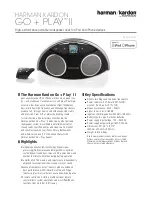
Delta Speaker
Installation Manual
1.
Unpack the speaker
a.
Place shipping box flat, with model and serial number label at the top.
b.
Cut packing tape, open the carton, and remove the accessories that are packed into the top foam
protection layer. These include the power cable, the four mounting brackets, and a pack of screws.
c.
Carefully remove the top layer of protection foam.
d.
Carefully remove the speaker from the carton. Do NOT pull it out by the waveguide
e.
Keep the box and packing material in case you need to ship it back for returns, maintenance or
upgrades.
2.
Prewire. Power, Signal, and Control network should be prewired to each Delta speaker
a.
Power: The Delta is an active speaker with built-in signal processing and amplification. It requires
about 600 Watts of available AC power in the range from 100V to 250V. We recommend prewiring
one 120V-20A circuit, or a 220 / 240V – 15A for each group of three Delta speakers, with either a
quad box near the three speakers, or a duplex near each speaker.
b.
Audio Signal: The Delta takes Analog Balanced audio signal over twisted pair with braided shield
XLR cable. It is best to prewire for it. An “RCA” unbalanced signal can also be fed to the Delta,
ideally through a balancing transformer as close to the source as possible. Jensen Transformer
makes very good balance adapter transform units. Note that even for unbalanced analog audio
sources it is best to use a twisted pair with shield cable. See the connection section below for
termination recommendations. It is also possible to use Cat5 or Cat 6 cabling to feed a balanced
signal to the Delta, using XLR connectors at the speaker end. A few manufacturers, including
MuxLab (model 500028) and Audio Control (BLD-10) make unbalanced to Cat5 converters which
can be used for unbalanced feeds (see Appendix 2). There may be residual noise interference in
environments with a lot of radio frequency noise. Contact Grimani Systems Technical Support for
further details.
c.
Control signal: The Delta is controlled and monitored through a USB interface. Using a USB to Cat5
converter, you can prewire with either Cat5, Cat5e, Cat6, Cat6a cabling from a central location to the
speaker, and add the converter unit at the speaker location. Terminate the Cat5 cables at a patch
panel at the equipment rack or other room location accessible during calibration. In all cases prewire
using Keystone punch-down connectors at wall plates or rackmount locations at the rack and
speaker locations. Test the connection using a certification meter to assure quality of connection and
bandwidth. The last interface should be accomplished with factory terminated and certified patch
cables.


























